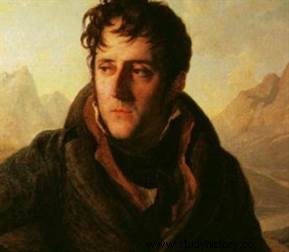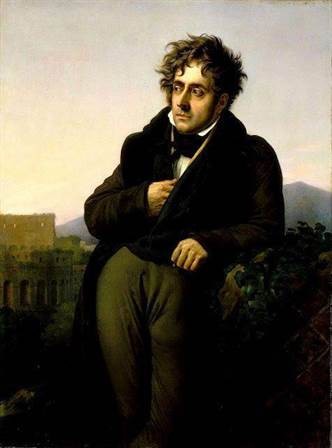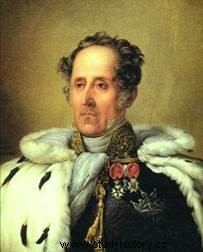 Short biography - Although he was an influential politician, François René de Chateaubriand (1768-1848) is best known as a talented writer and precursor of theRomantic movement. . Coming from an aristocratic class abused by the French Revolution, conservative, pious, he despises the materialistic rationalism of the Enlightenment, will not recognize himself in the First Empire and will be greatly disappointed by the Restoration. A free, extraordinary, melancholy and tormented man, François-René de Chateaubriand established himself as one of the greatest minds of the 19th century. As a child, Victor Hugo wrote in his notebooks:“I want to be Chateaubriand or nothing. »
Short biography - Although he was an influential politician, François René de Chateaubriand (1768-1848) is best known as a talented writer and precursor of theRomantic movement. . Coming from an aristocratic class abused by the French Revolution, conservative, pious, he despises the materialistic rationalism of the Enlightenment, will not recognize himself in the First Empire and will be greatly disappointed by the Restoration. A free, extraordinary, melancholy and tormented man, François-René de Chateaubriand established himself as one of the greatest minds of the 19th century. As a child, Victor Hugo wrote in his notebooks:“I want to be Chateaubriand or nothing. »
Biography of Chateaubriand
François René de Chateaubriand was born on September 4, 1768 into an old ruined aristocratic family, settled in Saint-Malo where the father had made a fortune in colonial trade. The youngest of 10 children (4 of whom died at an early age), François-René lives away from his parents, with his grandmother, in Plancoët. In 1777 the family moved to the Château de Combourg, François-René spent a childhood there which he would describe as often gloomy with a taciturn father and a superstitious and sickly, but cheerful and cultured mother. After his studies in Brittany, at the age of 17 he became a second lieutenant in the Navarre regiment commanded by his brother. In 1788 he came to Paris and established literary contacts, he began in this environment by writing verses for the Almanach des Muses .
In 1789, he participated in the Estates of Brittany and witnessed the storming of the Bastille. Two years later, Chateaubriand left revolutionary France for the New World, with the pretext of seeking the Northwest Passage. For a year he traveled in North America, living with the natives and sketching his Natchez poem there. In 1792, he married Céleste, with whom he had no children. He leaves for Koblenz with the army of emigrants, who have remained in Celestial Brittany and is arrested. Chateaubriand was wounded at the siege of Thionville, he was taken to convalesce in Jersey:it was the end of his military career.
He stayed in London, in total destitution, forced to give French lessons and do translations for booksellers. In 1794, his brother, his sister-in-law and part of their family were guillotined in Paris. In 1797 he published the Essai historique, politique et moral sur les Révolutions Anciens et Modernes, Consideres in their relationship with the French Revolution . It expresses political and religious ideas little in harmony with those which it will profess later, the work passes unnoticed by critics.
Back to Napoleonic France
Chateaubriand returned to France under the Consulate of Bonaparte in 1800. For a time, he edited the review le Mercure of France where he published in 1801 his novel Atala which arouses great admiration! Around the same time he composed René . In 1802, he published the Génie du Christianity partly written in England, and including Atala and René , originally, are only episodes. This eventful book signals a return to religion after the revolutionary dechristianization!
 Spotted by Napoleon, he was chosen to accompany Cardinal Fesch to Rome as first embassy secretary. He proposes to Céleste to follow him, but the latter, knowing his affair with Pauline de Beaumont, refuses the threesome... In 1804, he represents France consular near the Republic of Valais. When he learns of the Duc d'Enghien's execution, Chateaubriand resigns. His break with Napoleon was consummated with the proclamation of the Empire:Chateaubriand joined the opposition.
Spotted by Napoleon, he was chosen to accompany Cardinal Fesch to Rome as first embassy secretary. He proposes to Céleste to follow him, but the latter, knowing his affair with Pauline de Beaumont, refuses the threesome... In 1804, he represents France consular near the Republic of Valais. When he learns of the Duc d'Enghien's execution, Chateaubriand resigns. His break with Napoleon was consummated with the proclamation of the Empire:Chateaubriand joined the opposition.
Devoting himself only to Letters, Chateaubriand decided to write a Christian epic. Eager to visit himself the places where he is going to set the action, he leaves France (with the papers in order made by the imperial administration) and travels in 1806 Greece, Asia Minor, Palestine and Egypt .
On his return, exiled by Napoleon three leagues from Paris, he settled with his wife (who, incidentally, had also written his Souvenirs) in the Domaine de la Vallée -aux-Loups. It was there that he composed Les Martyrs , published in 1809. With his travel notes, he published in 1811 the itinerary from Paris to Jerusalem . The same year, he was elected a member of the French Academy. However, as he plans in his reception speech to blame certain acts of the Revolution, Napoleon does not agree to let him pronounce it:he is therefore not allowed to take possession of his seat before the Restoration.
Chateaubriand under the Restoration
Chateaubriand joyfully welcomes the return of the Bourbons, on March 30, 1814 he publishes a most virulent pamphlet against the fallen Emperor:De Buonaparte et des Bourbons . This pamphlet is distributed in thousands of copies. According to Chateaubriand himself, Louis XVIII would have said that this pamphlet served him as much as 100,000 men. Chateaubriand becomes ambassador to Sweden, but he does not have time to leave Paris when Napoleon, who has escaped from Elbe Island, begins his incredible reconquest of France! During the Hundred Days, he fled to Ghent in the King's baggage and even became a member of his cabinet (he also sent him a Report on the state of France ).
Back in Paris after Waterloo, Chateaubriand, a member of the Chamber of Peers, voted in December 1815 for the death of Marshal Ney (Marshal of Napoleon, who rallied to Louis XVIII and returned to Napoleon during the Hundred Days). Peer of France, Chateaubriand was also Minister of State, at least until he was disgraced for having attacked (in La Monarchie according to the Charter) the ordinance of September 5, 1816 which dissolved the "Chambre introuvable" (chamber deputies). Chateaubriand then returned to the opposition, among the ultraroyalists, and became one of the main editors of the Conservateur, while frequenting Mme Récamier's salon.
In 1820, during the assassination of the Duke of Berry, he wrote Memoirs on the life and death of the Duke which tend to bring him closer to the court. In 1821, he was appointed Minister of France in Berlin, then Ambassador in London and the following year represented France at the Congress of Verona (where France decided to intervene against the Spanish liberals). Upon his return, he became Minister of Foreign Affairs and managed the Spanish question successfully. However, he was fired in 1826, for not having been able to agree with the head of government, Monsieur de Villèle. Chateaubriand therefore returned to the opposition against de Villèle, but this time joining the liberal party. In the Chamber of Peers, as in the Journal des Débats, he wanted to defend the freedom of the press and the freedom of Greece, which earned him great popularity.
 At the fall of Villèle, he was appointed ambassador to Rome (1828), but he resigned at the accession of the Polignac ministry. Increasingly at odds with the conservative parties, disillusioned about the future of the monarchy, he retired from business after the Revolution of 1830, even leaving the Chamber of Peers. Having put an end to his political career, he only manifested himself in harsh criticism of the new government of Louis Philippe (De la Restauration et de la Monarchie élective , 1831), by trips to the fallen family, and by the publication of a Memory on the captivity of the Duchess of Berry (1833), memoir for which he was prosecuted, but acquitted. In 1831 he also published Historical Studies , summary of universal history where he wants to show Christianity reforming society. This work is the frontispiece of a History of France, meditated on for a long time, but unfinished.
At the fall of Villèle, he was appointed ambassador to Rome (1828), but he resigned at the accession of the Polignac ministry. Increasingly at odds with the conservative parties, disillusioned about the future of the monarchy, he retired from business after the Revolution of 1830, even leaving the Chamber of Peers. Having put an end to his political career, he only manifested himself in harsh criticism of the new government of Louis Philippe (De la Restauration et de la Monarchie élective , 1831), by trips to the fallen family, and by the publication of a Memory on the captivity of the Duchess of Berry (1833), memoir for which he was prosecuted, but acquitted. In 1831 he also published Historical Studies , summary of universal history where he wants to show Christianity reforming society. This work is the frontispiece of a History of France, meditated on for a long time, but unfinished.
He spent his last years in Paris, with his wife, completing the Mémoires d'outre-tombe begun since 1809. His last work, which was “commissioned” by his confessor, is Vie de Rancé , a biography of Dominique-Armand-Jean Le Boutillier de Rancé (1626-1700), worldly abbot owner of the Château de Véretz, in Touraine. Céleste died in 1847 and François-René followed her on July 4, 1848. Her remains were transported to Saint-Malo and placed facing the sea, according to her wishes, on the rock of Grand Bé, an islet located in the harbor of her birthplace. , which can be reached on foot from Saint-Malo when the sea has receded.
Chateaubriand's work
• Atala, or The Loves of Two Savages in the Desert (1801)
Young René is welcomed in Mississippi by the Natchez tribe. He is befriended by an old Indian, Chactas, who visited France in the time of Louis XIV. Chactas tells him about his youth, how he had been taken prisoner by an enemy tribe, but freed by the beautiful Atala, converted to Christianity. In their flight they meet Father Aubry who offers to unite them by the sacred bonds of marriage after having baptized Chactas. But Atala, whom her mother had consecrated to virginity, poisons herself rather than breaking the maternal vow, unaware that this vow could be released by the priest... In this work close to tragedy, Chateaubriand praises Christianity and describes a community close to that of the first fantasized hours of the primitive Church. This work inspired the painter Girodet who in 1808 created Atala au tombeau.
 • René, or the Effects of Passions (1802)
• René, or the Effects of Passions (1802)
René comes as a sequel to Atala , but this time it's a young Frenchman who tells his melancholy life to an Indian. This story filled with spleen and unease is often considered a standard work for the romantic movement. Several key themes are addressed:
- Loneliness:René is a solitary and tormented being, ultimately poorly integrated into the society of his time.
- Brotherly love:Only Amélie, René's sister, finds grace in his eyes. The quality of their relationship depends on the state of mind of the romantic hero. But behind the romance some wanted to see the passionate (but chaste) love of Chateaubriand for his sister Lucile.
- Travel:In search of calm, René is a great traveler... Like François René de Chateaubriand, by the way...
- Religion:Amélie is getting closer and closer to religion, to the point of taking orders. This situation torments René to the highest degree, torn as he is between heartbreak and admiration.
• The Genius of Christianity (1802) This work is written following a great return to the Faith of Chateaubriand, following the death of his mother:
In this key work of his bibliography, Chateaubriand seeks to demonstrate the superiority of Christianity over other religions and atheism. Taking most of his predecessors backwards, he does not seek to prove that Christianity is excellent on the pretext that it comes from God, on the contrary, he seeks to show that Christianity is excellent in fact, and that this underlies that it comes from God!
He therefore strives to study the contributions of Christianity to humanity in all areas:art, poetry, morality...
• The Martyrs, or the Triumph of the Christian Faith (1809)
In this novel, Chateaubriand follows a young Roman governor converted to Christianity:Eudore. Eudore frees Velléda, the daughter of a rebellious druid who resumes the fight... The story is that of an impossible love, Velléda falling madly in love with her enemy, Eudore, and the latter refusing to receive her... In spite, the beautiful druid ends up slitting her throat. But the tragedy does not stop there since Eudore himself succumbs, a martyr of Christianity...
Velléda becomes a theme for sculpture and painting.
• Of Buonaparte and the Bourbons, and of the necessity of rallying to our legitimate princes for the happiness of France and that of Europe (1814)
Anti-Napoleonic pamphlet for the occasion of the first abdication of Napoleon I.
• Memories from beyond the grave (1848)
This great autobiographical project is certainly Chateaubriand's best-known work. These Memoirs were originally to appear only fifty years after the death of the author, but it was otherwise, because to provide for financial problems Chateaubriand ceded the exploitation rights to a company which demanded that the book be published as soon as the death of the author. In a sense, these Memoirs are similar to those of Saint-Simon, or the Confessions of Rousseau:Chateaubriand evokes his personal life, but also the great historical events of which he was the contemporary:Revolution, Republic, Empire, Restoration... He works as a historian while revealing his Me and his melancholy.
Bibliography
- ETERSTEIN Claude (sdd), French literature from A to Z, Hatier, 2011.
- BERCHET Jean-Claude, Chateaubriand, Editions Gallimard, 2012.
- Chateaubriand, biography of Ghislain de Diesbach. Perrin, 2018..
